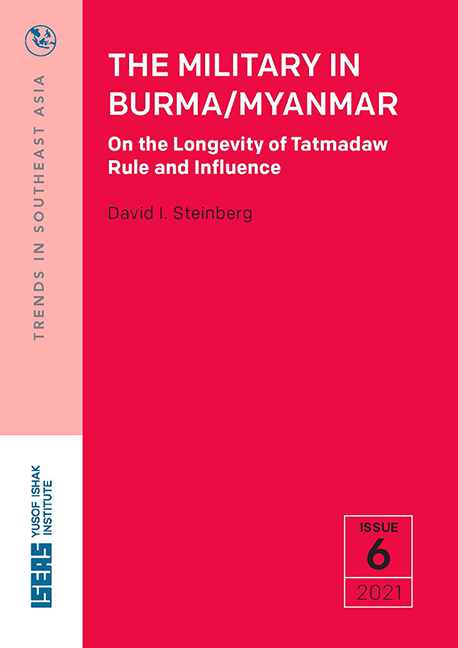The Military in Burma/Myanmar: On the Longevity of Tatmadaw Rule and Influence
Published online by Cambridge University Press: 29 October 2021
Summary
OVERVIEW
Burma was “quite unlike any land you know about,” so Kipling wrote. He thought it unique even if appended to India as a province. But he could not have predicted the future singular role of the military in that country, for the Tatmadaw has been, and remains, the longest-ruling military elite in modern Asia, and perhaps in the contemporary world. For over half a century it commanded power, ran the state, and has been pivotal since independence in 1948. Its dominance lay not only in its complete control over the powers of state coercion, but also in its early prestige and heritage, and, later, its vice-like grip on all important elements of the society.
Its militarized Burman leadership was the only Asian group that fought early against the Allies for independence early in World War II, despite very limited military training those participating received from their Japanese allies and before the Burmese (mostly Burmans) turned against the Axis in March 1945. Unusual in Asia, the military formedpolitical parties; this became a pattern. Its leader, Aung San, orchestrated a conference at Panglong in 1947 that brought some minorities into what became the Union of Burma. He negotiated independence from Great Britain in 1948, and his assassination just before its fruition gave an almost mystic reverence to him, his family, and those military personnel associated with him. The Tatmadaw saved the state from multiple communist and ethnic rebellions in the 1950s, tried (unsuccessfully) to counter fleeing Nationalist Chinese anti-communist remnants that occupied some of Burma's northern reaches, and later, on multiple occasions, prevented actual and perceived threats of secession and what it continuously referred to as internal “chaos”. In 1958, it unfortunately acquired both false confidence in its capacity to govern and to manage an economy as well as in the widespread, inevitable corruption of its civilian elite.
This leadership was early viewed, and viewed themselves, as patriots and defenders of the state, and the Tatmadaw was a most desirable career, the officer class graduating from the Defence Services Academy at Maymyo with University of Rangoon degrees, although they were too junior to become leaders of the 1962 coup.
- Type
- Chapter
- Information
- The Military in Burma/MyanmarOn the Longevity of Tatmadaw Rule and Influence, pp. 1 - 37Publisher: ISEAS–Yusof Ishak InstitutePrint publication year: 2021

